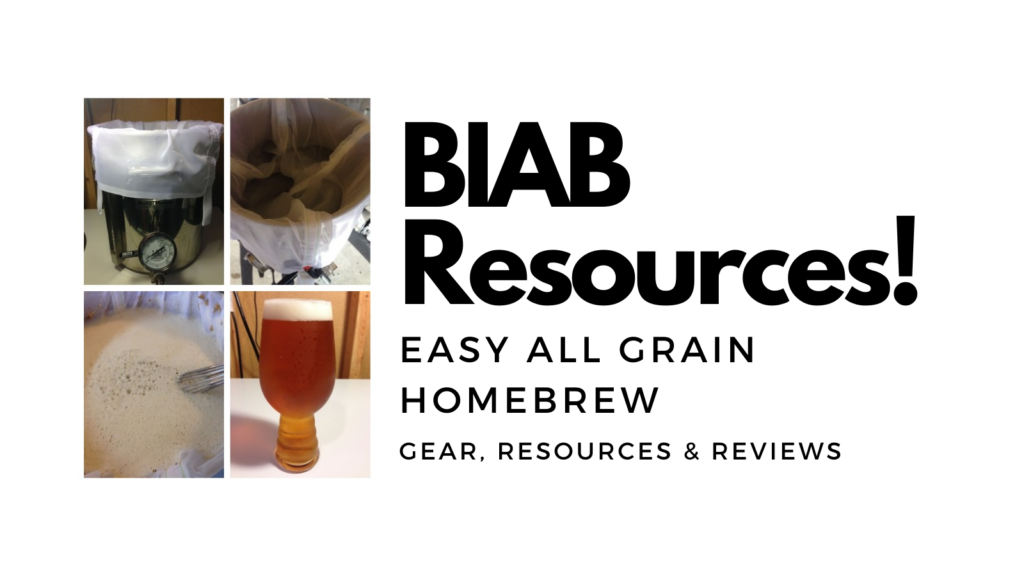
BIAB: Brew in a Bag – Easy All Grain Homebrew! – Gear, Resources & Reviews
Brew in a Bag, also known as BIAB is a bit of a misnomer. Brewing in synonym for boiling. We’re not really boiling in a bag. BIAB deals with the mashing, lautering and sparging phase of all grain brewing. What’s really going on is Mash in a Bag or MIAB. Having said that, BIAB is the term that’s commonly used and we’ll stick with that.
What is BIAB and how is it different from traditional mashing?
In traditional all grain homebrewing a mash takes place in a mash vessel aptly called a mash tun. During the mash enzymes convert complex carbohydrates into simple sugars that can be fermented by brewer’s yeast. Homebrew mash tuns take many forms but a typical setup is a cooler combined with a false bottom or screen. After the mash is complete a sparge takes place to rinse residual sugars from the now spent grains. This can take a couple of different forms in homebrewing either fly/continuous sparging or batch sparging.
in BIAB we simply substitute a bag filter for the false bottom and any required fittings and ball valves. The cooler is typically replaced by your boil kettle. Same chemistry behind the scenes and the same basic outcome – complex carbohydrates converted to simple sugars ready to be fermenter. Just a change in equipment.
Benefits of BIAB
- Cost savings. A $10 to $30 bag replaces ~$100++ worth of coolers, fittings, ball valves and false bottom. Whatever you would spend on a mash tun and HLT.
- Space savings. Guess what, that 10+ Gallon Mash Tun takes up space. It needs to be stored someplace. A bag folds up to almost nothing, that’s just not true of a cooler.
- Time savings. No mash tun to clean up on brew day. Brew day, for most BIAB brewers, consists of using a single vessel for mashing and boiling. Also, if you employ a no sparge technique, you cut out another good chunk of time.
- Direct fired mash tun. If you use your boil kettle as a mash tun that also means you can direct fire it to maintain mash temperatures, perform step mashes and mash out. Make sure and stir when applying heat to prevent scorching the bag – or check out the stainless false bottoms linked below.
- Hit your pre-boil volumes every time. BIAB really takes grain absorption estimates out of the mix. If I start with a reasonable water volume (see spreadsheets below for estimating), I can hit my pre-boil volume every time. I let me bag drip until I hit my pre-boil volume right on the nose and then remove it.
- BIAB + Small Grain Brewing means entry into homebrewing, starting at the all grain level is easy and economical. See: Step by Step Small Batch, All Grain Stove Top Brewing
Downsides of BIAB
- Ingredient costs. You may use a little more grain to make up for efficiency losses. Since BIAB is typically (but not always) a no sparge method, some sugars can be left behind. This is mitigated by a couple of factors. First, you can crush your grain more aggressively vs traditional mash methods. A stuck sparge is of little or no concern using BIAB. An aggressive crush helps to make up for efficiency losses. Second, I believe that a full volume mash (as is typically used by BIAB brewers) is more efficient that a thick mash. Alternatively you can sparge if you want to completely eliminate this concern and possibly make it into a benefit (aggressive milling + sparging = better efficiency as compared with traditional methods). As for me, additional ingredient costs are of minimal concern in my opinion. This doesn’t amount to much, if anything for most beers and I would rather realize time savings on brew day.
- Lifting the bag. Depending on the beer, the amount of grain and the bag used, lifting a soaked bag of grain can be an issue. If this is an issue for you, considering rigging up a (safe) pulley system to assist.
- Temperature drift. An uninsulated boil kettle probably drifts more than a well insulated cooler based mash tun. Given the mass we’re talking about this is probably less of an issue than you may think. However, it’s probably a fair point to make. You can address that by adding insulation or, what I do is check temps half way through and add a little bit of heat. This usually takes just a couple minutes.
Resources, Reviews and Gear
- The Brew Bag is a Made in the USA, purpose designed BIAB bag – Hands on Review
- Brew In a Bag – Bag Material – Does it Matter? by Rex Slagel + includes a 10% Off Coupon for The Brew Bag
- 24″ x 26″ Nylon Bag for BIAB affiliate link, note that multiple variations of this product may be available, as such a different version may appear at this link
- Shop Around: Search Amazon for “BIAB homebrew bag”
- Pulley Lifting Set – via William’s Brewing
- Extra Large (26″ x 22″) Reusable Drawstring Straining Brew in a Bag affiliate link, note that multiple variations of this product may be available, as such a different version may appear at this link
- A bag full of grain can be heavy and difficult to lift! Check out the 440 lb capacity electric hoist along with a photo of this in action for BIAB brewing and some tips
- Bayou Classic 1160 62-Quart All Purpose Stainless Steel Stockpot affiliate link, note that multiple variations of this product may be available, as such a different version may appear at this link. Includes a stainless basket that may be helpful for BIAB. Also available in a 44 quart size
- BIAB Brew Day Spreadsheet – Brew Day spreadsheet geared for Brew in a Bag/BIAB style brewing. This spreadsheet has an anytime gravity estimate and correction calculator to help you project and correction gravities. Instead of a one page summary, the entire spreadsheet is setup to print out on a single 8 1/2 by 11 piece of paper. Includes narrative step by step directions.
- Small Batch BIAB Spreadsheet – Brew in a Bag, but this time a simplified version for small batch BIAB brewers. This is designed to make homebrewing easy and the post contains a step by step how to for brewing small batch all grain homebrews on your stovetop.
- Update International FW-24 Stainless Steel French Whip, 24-Inch – Hands on Review affiliate link, note that multiple variations of this product may be available, as such a different version may appear at this link. This is my homebrewing stirring tool of choice. It works particularly well for BIAB as the rounded ends of the whisk work well with the BIAB bags I’ve used. No sharp edges to rip or tear the bag.
- BIAB Brew in a Bag Kettle Kit – via MoreBeer – kettle and bag combo for BIAB
- eBIAB alternatives – a new generation of electric all grain brewing systems are now available that use a BIAB approach. Cost savings typically fly out the window with these options, but the do offer some advantages and deserve to be mentioned here because of their similarity to BIAB style mashing – Grainfather, Hands on Review: Brewer’s Edge Mash & Boil Electric Brewery, Hands on Review: Robobrew All Grain Brewing System, Hands on Review: Brewer’s Edge Mash & Boil Electric Brewery and Hands on Review: Wort Hog Turnkey Electric e-BIAB System
Things Change!
Shop around… Search Amazon for BIAB Brewing Bag
Mill Reviews!
Everything All Grain!
Our resource post on all grain is the source for everything all grain!
More Homebrew Finds!
- Last 50 Finds!
- Top Deals – a curated list of the best deals
- Homebrew Reviews – one of the largest libraries of homebrew reviews in existence!
- Our Top Posts – tips, how-tos, resources posts and more
- Let’s be Friends!
Recent Deals!
10 Most Recent Homebrew Resource Posts & How-To’s!
We are Homebrew Review HQ! Our 10 Most Recent Reviews
pinnedThis post may contain affiliate links. We may make a commission when you use our links. This will never cost you extra. Thank you for supporting Homebrew Finds!
greatdealsThis is a Top Post! See: All Top Posts
Make sure the components you use are compatible and rated for your intended application. Contact manufacturer with questions about suitability or a specific application. Always read and follow manufacturer directions. tag:lnksfxd toppost:resourcesbiab tag:tpr





















I bought a small roll of Reflectix from Amazon to make an insulation cover for my 44qt Bayou Classic kettle. It was about $12 plus some duct tape I had around the house. I made it to fit a little loose so that it can go down over my site glass and the handles. I have a little cutout for the ball valve and then a top cover I made so I can lift the lid and stir halfway thru the mash time. I leave my temp probe in so I can monitor the temp. I am generally able to hold within a degree F during 60-90 min mash in any weather. This was a huge change for me. Next step was water volume calc with biabcalculator.com and then learning to adjust water salts with brunwater spreadsheet. now I hit my numbers every single time. Make sure to verify what your boil off rate is with your particular kettle and burner. I also bought a hotter burner to speed things up and it was worth it. Gas One 120k BTU.